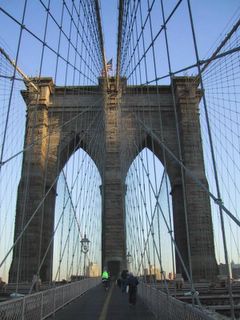West Indian American Day Carnival
The Caribbean Sea is so close to New York City that it is possible to hop on a flight at JFK Airport and be on a sun-drenched beach in about two hours. This proximity, combined with the difficult political and economic conditions in many areas of the Caribbean, has led to a continuing wave of immigrants from the region. Although they may have left their tropical homes behind, many of the Caribbean immigrants brought their distinctive island cultures with them. Over time, their music, food and celebrations have become woven into the fabric of New York.
Caribbean Carnivals have been held in the streets of New York for decades. The biggest, the West Indian American Day Carnival, is a Brooklyn Labor Day tradition. The celebration is a combination street fair and parade, and the day is colorful, loud and chaotic. Everywhere, the people and music jostle for space and air. The pulsing rhythms of reggae drown out the steel drums of calypso, which give way to the brass and drums of soca. Shouting vendors circulate through the crowd hawking t-shirts, hats, towels, flags, bracelets and whistles emblazoned with the flags of West Indian nations. Young men spread counterfeit CDs and DVDs on the sidewalks next to booths selling handicrafts, toiletries and sweetly burning incense.
The sidewalks of the parade's route, the Eastern Parkway, are crowded with food vendors that fill the air with tantalizing aromas. The variety is astounding - everything from slick professional restaurants with neat, tidy signs and deluxe tents to grandmothers shyly offering a cardboard box full of cookies and slices of homemade cake carefully tucked into plastic baggies to lone men drinking and cooking mysterious bits of meat on greasy hibachi grills.
Because this was the first time I attended the Carnival, I hadn't been aware of two significant differences between this and most parades in New York, both of which made photographing the event a challenge:
1) At the West Indian Carnival, the crowd easily spills over the barriers, mingling and mixing with the official participants.
2) Parade participants compete for prizes and the judging stand is set up in front of the Brooklyn Museum, at the very end of the parade. That means that participants are expected put on their biggest, most energetic performance of the day after walking in the blazing sun for hours. As a result, many of the dancers and marchers contain their energy and pass the time (and miles) eating, drinking, chatting and talking on cell phones, not launching their full-out finest performances until they are in view of the judges.
The lesson: anyone who attends with hopes of photographing the participants in all their glory should arrive early and stand as close to the judges' stand as possible. And wear a hat! 
Angel on stilts 

Orange plumes and green cape 

Waving the flag 

Checking the cell phone 

Two of New York's finest 

Large food stand 

Cow heel souse 

Sweet as her home made cakes 

Surrounded by masks 

Pink ladies 

Harlequin 

Uniforms 



0 Comments:
Post a Comment
<< Home